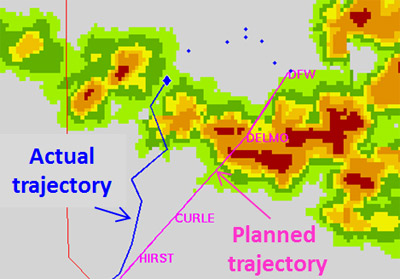The concept of “Be Prepared” is relevant in various aspects of life- including investing, personal development, and emergency preparedness, however it extends beyond that emphasising the importance of foresight, planning, and readiness for various situations. It encourages individuals to be mentally, physically, and practically prepared for challenges and opportunities. In this article we will look at aviation weather hazards, effects and defences.
Weather Avoidance Characteristics
During active weather conditions, the workload increases for flight crew and controllers because-
- Non standard traffic flow – the traffic flow is irregular and not easy to anticipate because of:
- the cell movement both horizontally and vertically.
- weather avoidance depends on the route and altitude of aircraft
- Creation of bottle neck – Due to storms, the available airspace reduces thus creating restrictions on capacity and subsequent delays.
- New conflict points – re-routing creates new traffic conflicts thus increases workload for controllers and aircrew.
- Increased frequency occupancy time due to revised clearances and re-routing.
- Increased coordination with adjacent sector or FIR due to space constraint and detours.
- Rapidly changing situation – isolated thunderstorms may evolve quickly into squall line thus increasing challenges for pilots and controllers.
- Turbulence and or Icing – May force pilots to reduce speed or request for descent. In such a case, it might be advisable to downgrade RVSM airspace and introduce 2000 ft vertical separation.
- There could be further contingencies where crew may be unable to maintain desired heading or level or speed. This may create additional conflict points and increased frequency occupancy time. More applicable in busy TMAs.
Weather: Consequences
Possible effects of adverse weather avoidance include:
- Pilots may be unwilling or unable to change heading as instructed by the controller to avoid conflict, due to proximity of adverse weather.
- Pilots may be unwilling to descend or descend early due to proximity of adverse weather area.
- Pilots may reduce speed speed due to turbulence (which usually exists in or near Cbs).
- Due to proximity of weather, Pilots flying a heading or altitude or speed not expected by the controller.
- Some pilots may request for rerouting or change of runway due to Cb cell proximity to a approach path.
Defences
Controllers Workload may be managed with the following actions:
- Maintain awareness of the adverse weather location, its evolution (laterally and vertically) and of the possible deviation routes. Met Department should alert controllers to the presence of adverse weather. Radar observations, information from adjacent ATS units and Satellite pics should be utilised to further build up situational awareness.
- Develop strategies to mitigate effects of weather avoidance and route deviations.
- Provide timely information to and coordinate with the adjacent sectors of any deviations which will affect them.
- Pro-actively seek information regarding traffic which is likely to enter own sector.
- Request any necessary details from the flight crews on the planned avoiding actions i.e. heading(s) on which the aircraft will be flying, as well as the estimated duration and/or the distance the aircraft will proceed on the heading(s).
- Provide extra room for manoeuvring, if in doubt that the traffic could request further deviation provide extra space for separation, issue instructions for flight level change as necessary, provide traffic information, as necessary.
- Inform pilot if weather avoidance will take pilot outside controlled airspace and offer an appropriate service.
- Establish a co-ordination pattern with the MET office for the provision of periodic weather updates and forecasts for the affected area.
- Use all available information: MET updates/forecasts, traffic load forecasts and availability of ATC personnel to assess the situation and establish with the help of local flow management position (FMP) possible tactical measures.
- Inform affected adjacent units of the (flow) measures taken.
- Provide additional controller as necessary at the sector to help the sector team with coordination / monitoring / planning tasks, as applicable.
- Open additional sectors in order to deal with possible capacity problems and avoid sector overloads.
- Consider the application of reduced departure rate or of a specific departure separation (e.g. individual approval request; departure interval of 5 minutes etc.) for aerodromes within the affected airspace and coordinate this course of action with the relevant units.
- If relevant, coordinate with respective parties release of temporary restricted airspace for use by general air traffic or its use under special crossing co-ordination procedure (e.g. use of dedicated SSR code).
- Consider the rejection/adjournment of planned maintenance work on any technical equipment used for ATS provision.
Weather Avoidance Decision Support Systems
It is important to develop standard operating tools to manage traffic deviations caused by adverse weather. The supporting procedure may be initiated based on weather forecasts or actual weather related deviations.
- Duties and responsibilities of Met department to provide necessary weather inputs for initiating Weather Avoidance Decision Support System.
- Coordination strategy with neighbouring ATS units.
- Opening additional routes or sectors for traffic flow in coordination with ATS units.
- Provisioning of additional controllers under these conditions.
Based on the experience and further research; DGCA, India may develop a model for each FIR and ATS units. Local ATS units may follow Weather Avoidance Decision Support system to substitute the normal operating procedures. Based on information the controllers needs to coordinate the commencement of Weather Avoidance Decision Support System.
Be Sae. Fly Safe.
I urge you to read the blogs related to pre-monsoon weather, if you have not done so. Just click on the links below.
Interesting Facts about Thunderstorms
Understanding Pre-Monsoon Weather
Pre-Monsoon Season and Aviation Hazards



